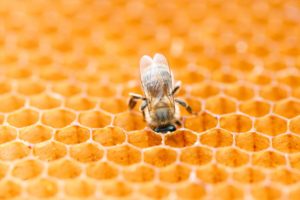If you’re a patient receiving venom immunotherapy, then you know how scary bee and wasp stings can be. Even with treatment, you may experience fear if you see a stinging insect outside. While you know the research says venom immunotherapy is effective, how can you know it is effective for you? We’ve done some research, chatted with an allergist, and are here to provide answers. If you’re wondering whether your allergy treatment is working for you, keep reading.
CAN AN ALLERGY TEST REVEAL THE EFFECTIVENESS OF VENOM IMMUNOTHERAPY?
The first step to discovering if you have a bee or wasp allergy is to get tested. A blood test is able to show a patient’s number of IgE allergic antibodies. The more you have, the more likely you are to have an allergic reaction. So, can you take another blood test to check your improvement after treatment?
Ask as Allergist: Testing Progress of Venom Immunotherapy Treatment
We asked Dr. Steven Kernerman at Spokane Allergy & Asthma this question. Here’s his response:
“Unfortunately, a blood test or skin test would not be the most reliable way to know if they have made ‘progress’ in no longer being at risk for a reaction in the future. It is true that a negative test would be encouraging, however, in general there does seem to be a disconnect being desensitized/immune tolerant and the testing results.”
Sadly, while testing seems like an obvious solution, it won’t provide the answers we’re looking for.
Why Blood Testing Doesn’t Provide the Answers
Out of curiosity, we asked Dr. Kernerman to explain why blood testing doesn’t reveal the body’s ability to tolerate an allergen.
“One hypothesis is that if gaining immune tolerance results in increases of IgG specific antibodies associated with tolerance, these might outweigh the effect of the remaining IgE allergic antibodies. This might thus tip the balance toward tolerant reactions and not toward allergic reactions, despite allergic antibodies still being present.” – Dr. Steven Kernerman
Essentially, Dr. Kernerman is saying that when you receive venom immunotherapy, you aren’t actually getting rid of all the IgE allergic antibodies found in the blood test. Instead, your body is reducing some of the IgE antibodies while creating new antibodies (IgG) that promote a tolerance to stinging insect venom. Allergy blood tests can look for these positive antibodies. However, comparing your IgE and IgG antibodies doesn’t paint a clear picture of what a future sting may look like for you.
Why Skin Testing Doesn’t Provide the Answers
So, we’ve ruled out blood testing, but what about skin testing? Typically, skin testing will remain unchanged during the first 2-3 years of treatment.3 In fact, skin testing results may never change, but venom immunotherapy isn’t meant to reduce on-site, skin-related irritation. The goal of venom immunotherapy is to prevent a systemic, or full-body, response to an allergen. This is why skin testing also does not accurately capture the success of treatment.
Remember, when being tested for a severe allergy, physical testing is only one piece of the puzzle. Patient history, and the symptoms that accompany a past reaction, often say more than the test results. Your story plays a large role in determining your allergy. So how does your story also reveal the effects of your treatment?

THREE WAYS YOU CAN KNOW YOUR VENOM IMMUNOTHERAPY TREATMENT IS WORKING
While testing isn’t an option, there are three other ways to find security in your treatment. First, you can know that you are receiving the right dosing. Second, you can evaluate how your body is responding to injections over time. Lastly, being stung (even though we hope this doesn’t happen!) can show your progress.
Right Dosing Provides Protection
Venom immunotherapy injections contain bee and wasp venom. When a patient first starts receiving shots, the amount of venom is minimal. Over time, the amount of venom is increased until the recommended dose for treatment is reached. This dose is called the “maintenance dose.”
Clinical Studies Prove Adequate Dosing
According to the documentation for the venom used in treatment, 100 micrograms is the recommended maintenance dose.6 This is dosing specifically for the treatment that contains venom from one type of stinging insect, like yellow jacket. There is another product that uses a mix of venoms from different stinging insects, and its recommended dosing is 300
micrograms.
This dosing is based on research that determined the amount of allergen needed to provide adequate protection to patients. Therapy that includes a 300 microgram dose of mixed vespid venom is 97% effective in completely preventing systemic allergic reactions to stings.6 This statistic is founded on a clinical trial, in which 97% of the patients showed no systemic reaction after an insect sting challenge. The remaining 3% had a milder reaction in comparison to their reactions prior to treatment. 6
Venom Injections vs. Venom from Stings
So, now you know how many micrograms of venom you could be receiving in your maintenance shots. How much venom would you encounter if you were stung?
Of course, the amount of venom you come into contact with has many factors. What type of insect stung you? How many times were you stung? How quickly did you remove the stinger? Did you accidentally squeeze the stinger and release all the venom from the sac?
We can’t ever be sure how much venom will accompany a sting. However, Guidelines
from the EAACI (the European Academy of Allergy and Clinical Immunology) state that a maintenance dose of 100 micograms of venom is “equivalent to the dry weight of approximately two honeybee stings or five wasp stings.” Most likely, a future sting will not contain significantly more venom than is being delivered through maintenance dose injections.

Noticing How Your Body Responds to Injections
Working up to the maintenance dose of venom immunotherapy can be uncomfortable. Over time, patients should witness the side effects decrease. There is also a need to be realistic – these are shots containing stinging insect venom! A certain level of discomfort is expected. But if you’ve been receiving venom immunotherapy treatment for some time now, think back to your first injections. Remember the symptoms of your first maintenance shot. Do you feel like you’ve seen a change?
You can discuss this with your allergist! Provide them with your insights and ask for theirs. A simple conversation could give you extra confidence and peace of mind.
Experiencing Your First Sting After Maintenance Dose
We hope no one is stung, nor do we think anyone should seek out being stung. However, over the years, we have heard so many stories of people being stung after starting venom immunotherapy. They didn’t have a reaction! From a scientific perspective, this may seem obvious. The research says patients on venom immunotherapy only have a 3% chance of systemic reaction.6 But nothing quite provides peace of mind like first-hand experience.
While we hope you never experience another bee or wasp sting, you very well might. If you do, remain calm the best you can. Notice your body! Your commitment to your health and treatment will show. It may not be perfect, but the risk for anaphylaxis is extremely low. Trusting all you’ve learned about your allergy treatment and taking some deep breaths can help more than you know.
Of course, do your best to carry epinephrine if you have a prescription for it. Don’t hesitate to call 911 if you are concerned.
Bee sting allergies are serious
YOUR FIRST LINE OF HELP: YOUR DOCTOR
If you have more questions about how venom immunotherapy works, and if it is working for you, please talk to your doctor. They are a great resource! Don’t be shy to advocate for yourself. Take extra care to express if you don’t understand something. Being protected from anaphylaxis is important. Knowing you’re protected is just as crucial.






